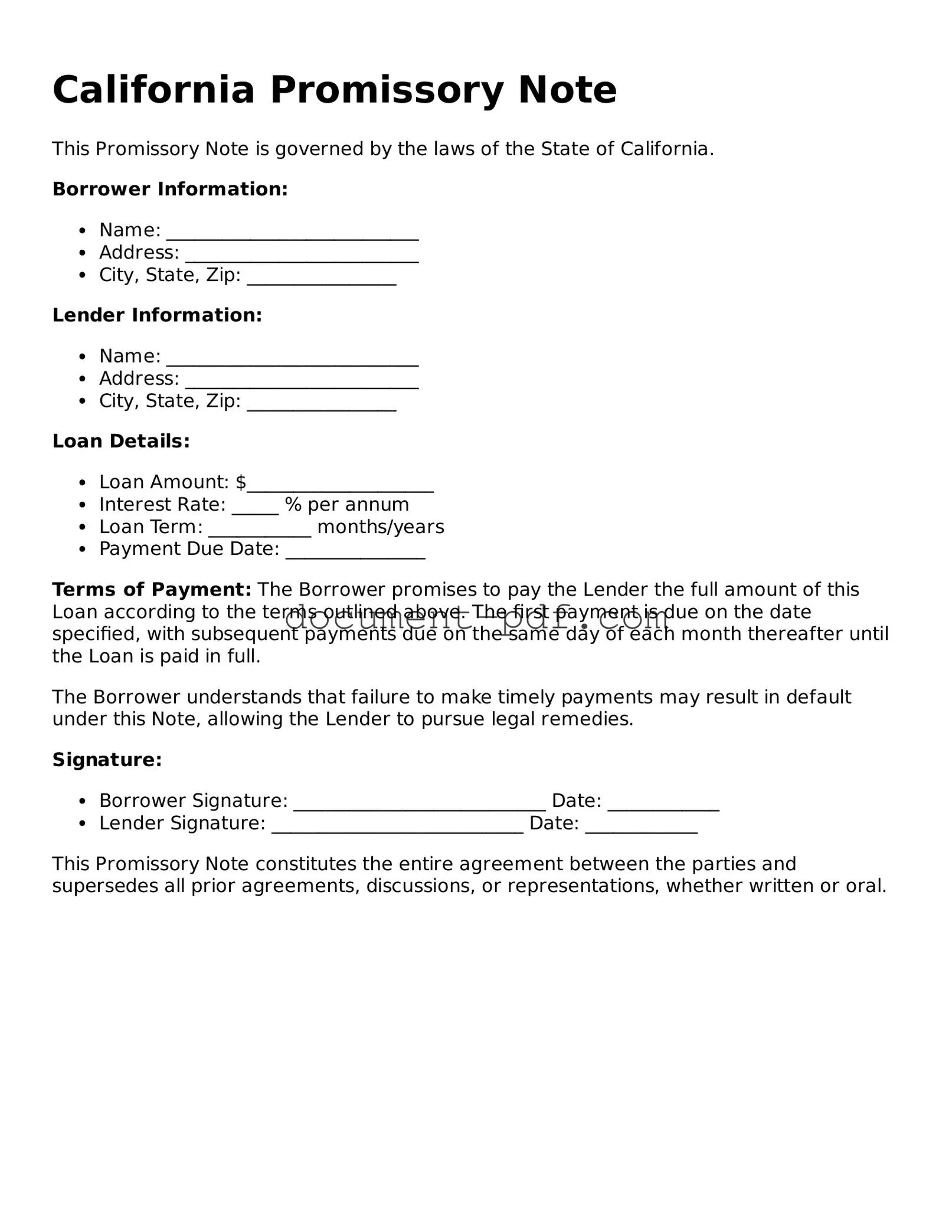A California Promissory Note is similar to a Loan Agreement, as both documents outline the terms of borrowing money. A Loan Agreement typically includes details about the loan amount, interest rate, repayment schedule, and any collateral involved. Like a Promissory Note, it serves as a legal contract that binds both the lender and borrower to the agreed-upon terms, ensuring that both parties understand their rights and obligations regarding the loan. However, a Loan Agreement may be more comprehensive, often covering additional aspects such as default provisions and dispute resolution processes.
Another document that shares similarities with a California Promissory Note is a Mortgage Agreement. While a Promissory Note is primarily focused on the promise to repay a loan, a Mortgage Agreement secures that promise with real property. In essence, the borrower pledges their property as collateral for the loan. Both documents are essential in real estate transactions, but the Mortgage Agreement adds a layer of security for the lender, ensuring they have a claim on the property if the borrower defaults.
A Credit Agreement is also comparable to a Promissory Note. This document is often used in business financing and outlines the terms under which a lender extends credit to a borrower. Similar to a Promissory Note, a Credit Agreement specifies the loan amount, interest rate, and repayment terms. However, it may also include provisions for fees, covenants, and conditions that the borrower must meet. Both documents serve to formalize the lending process, but a Credit Agreement is generally more detailed and tailored for larger, more complex transactions.
The Installment Loan Agreement is another document that resembles a California Promissory Note. This type of agreement outlines the terms for a loan that is repaid in regular installments over time. Like a Promissory Note, it details the loan amount, interest rate, and repayment schedule. The key difference lies in the structure of the repayments; an Installment Loan Agreement typically specifies fixed monthly payments, while a Promissory Note may allow for more flexible repayment options. Both documents are designed to protect the interests of the lender while providing clarity to the borrower.
A Secured Note is also similar to a California Promissory Note, as it involves a loan that is backed by collateral. In this case, the borrower agrees to provide an asset, such as a vehicle or equipment, as security for the loan. Both documents outline the repayment terms and obligations of the borrower. However, a Secured Note emphasizes the collateral aspect, making it clear that the lender has rights to the asset in case of default. This added layer of security can make it easier for borrowers to obtain financing.
Another related document is the Demand Note. This type of note allows the lender to demand repayment of the loan at any time. Like a California Promissory Note, it outlines the amount borrowed and the interest rate. However, a Demand Note does not specify a fixed repayment schedule, giving the lender more flexibility. Both documents serve as a promise to repay, but the Demand Note offers the lender a more immediate recourse if they need their funds back sooner rather than later.
A Subordination Agreement is also worth mentioning, as it can be connected to a Promissory Note in certain situations. This document is used when a borrower has multiple loans secured by the same asset. A Subordination Agreement establishes the priority of claims among lenders. While it does not serve as a promise to repay in the same way a Promissory Note does, it complements the Promissory Note by clarifying the order in which lenders will be repaid in case of default. Both documents work together to protect the interests of all parties involved.
For those looking to manage their affairs during times of incapacity, the Georgia General Power of Attorney form serves as a vital legal tool, enabling a designated person to handle a wide range of financial matters on your behalf.
Another similar document is a Personal Loan Agreement. This agreement outlines the terms of a loan made between individuals, often without the involvement of financial institutions. Like a California Promissory Note, it specifies the loan amount, interest rate, and repayment terms. Both documents serve to formalize the lending process and protect the interests of the lender. However, Personal Loan Agreements may be less formal and can vary widely in terms of structure and content, depending on the relationship between the parties involved.
Lastly, a Loan Modification Agreement can be related to a Promissory Note in situations where the original loan terms need to be changed. This document outlines the new terms of the loan, such as adjusted interest rates or extended repayment periods. While a Promissory Note sets the initial terms, a Loan Modification Agreement allows for flexibility in response to changing circumstances. Both documents are essential in managing the borrower-lender relationship, ensuring that both parties remain informed and in agreement regarding the loan's terms.
